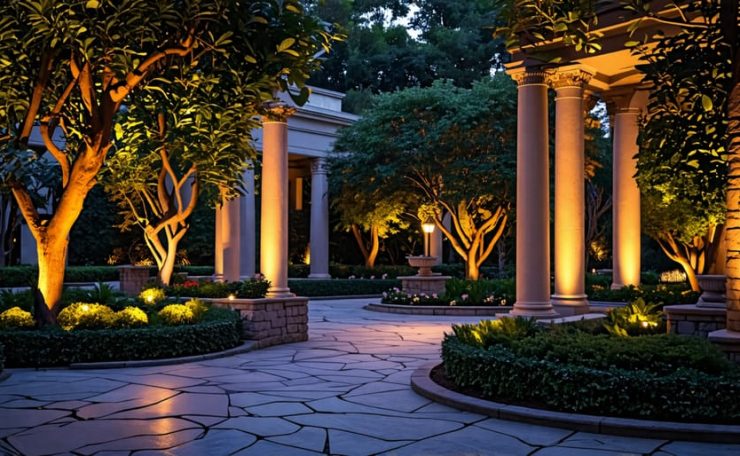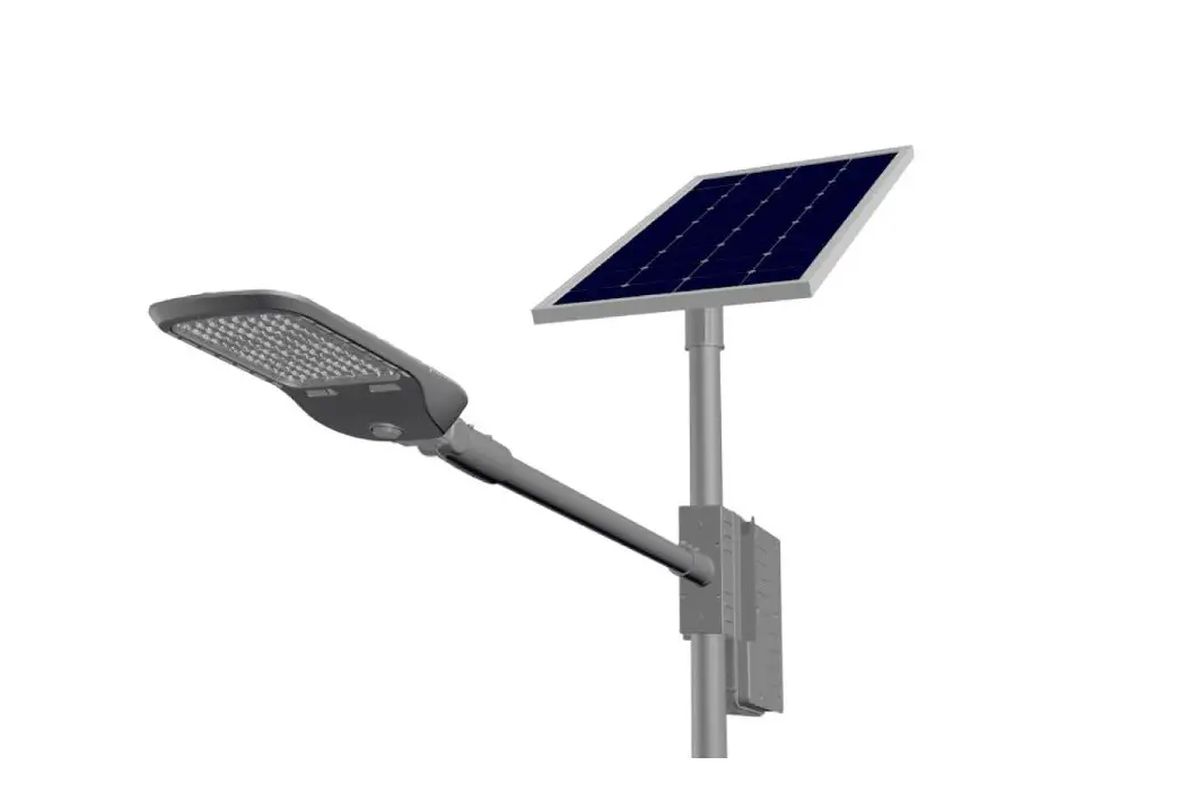Harness the power of uplighting to transform your landscape with these expert tips:
Design a layered lighting scheme that highlights key features, creates focal points, and adds depth. Position uplights at the base of trees, columns, and architectural elements for dramatic effect.
Choose high-quality, weather-resistant LED fixtures with adjustable beam angles. Opt for warm color temperatures (2700K-3000K) for a natural, inviting ambiance.
Conceal fixtures behind rocks, plants, or built-in niches for a seamless, polished look. Use dimmers, timers, and smart controls to customize light levels and create dynamic nighttime scenes.
Aim for a subtle, balanced effect that enhances your landscape’s natural beauty. Start with a few strategically placed uplights and add more as needed, ensuring each fixture has a specific purpose.
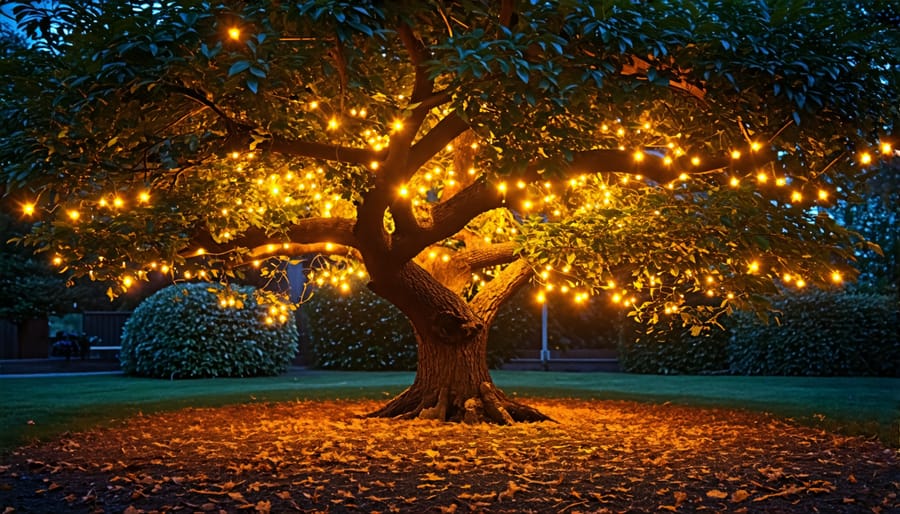
Benefits of Uplighting in Landscaping
Enhancing Architectural Features
Uplighting is a powerful tool for enhancing the unique architectural features of your home or business. By strategically placing light fixtures at the base of columns, walls, or other structural elements, you can create dramatic shadows and highlights that emphasize their form and texture. This technique works particularly well with stone, brick, or wood surfaces, as the interplay of light and shadow brings out their natural beauty. Uplighting can also be used to accentuate ornate details like cornices, moldings, or sculptures, making them stand out against the night sky. By carefully selecting the color temperature and beam angle of your fixtures, you can create a warm, inviting ambiance that showcases your property’s best features. Whether you’re looking to highlight a grand entrance, a stunning facade, or a cozy outdoor living space, uplighting is an effective way to add depth, dimension, and visual interest to your landscape lighting design.
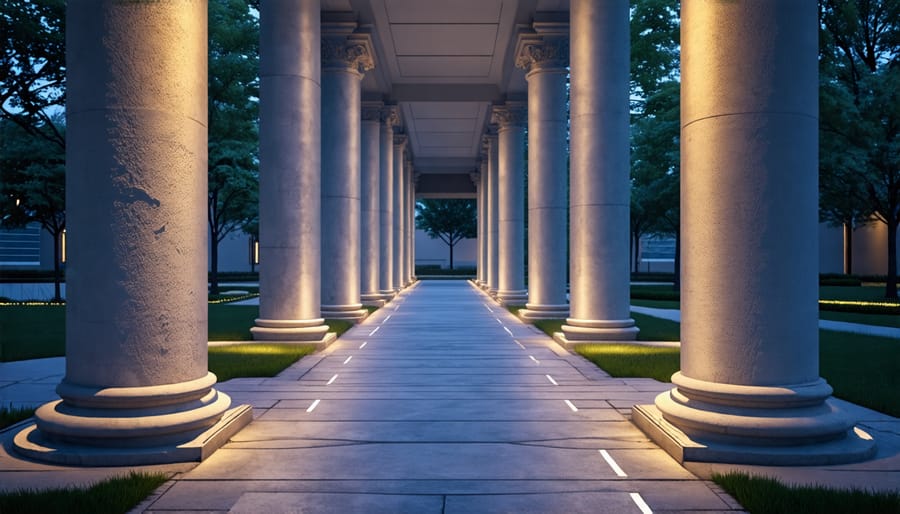
Creating Depth and Drama
Uplighting is a powerful tool for creating depth and drama in your landscape. By strategically placing lights at the base of trees, walls, or other features and angling them upwards, you can highlight the textures and shapes of these elements while casting intriguing shadows. This technique adds visual interest and dimension to your outdoor space, making it appear more layered and dynamic.
Uplighting can also be used to create dramatic focal points in your landscape. By illuminating a striking tree, sculpture, or architectural feature, you draw the eye and create a captivating nighttime display. Experiment with different angles and intensities to achieve the desired effect, whether it’s a subtle glow or a bold, theatrical statement.
When designing your uplighting scheme, consider the interplay of light and shadow, as this is what gives your landscape its sense of depth. By carefully selecting which features to highlight and which to leave in darkness, you can craft a visually stunning and immersive outdoor environment.
Improved Safety and Security
Uplighting not only enhances the beauty of your outdoor spaces but also plays a crucial role in improving safety and security. By strategically placing uplights around your property, you can illuminate dark areas, walkways, and potential tripping hazards, reducing the risk of accidents. Well-lit exteriors also deter intruders and create a sense of security for homeowners and visitors alike. Uplighting can be used to highlight architectural features, making it easier to navigate around your property at night. With the right placement and intensity, uplighting provides a welcoming atmosphere while ensuring that your outdoor spaces remain safe and secure.
Choosing the Right Uplighting Fixtures
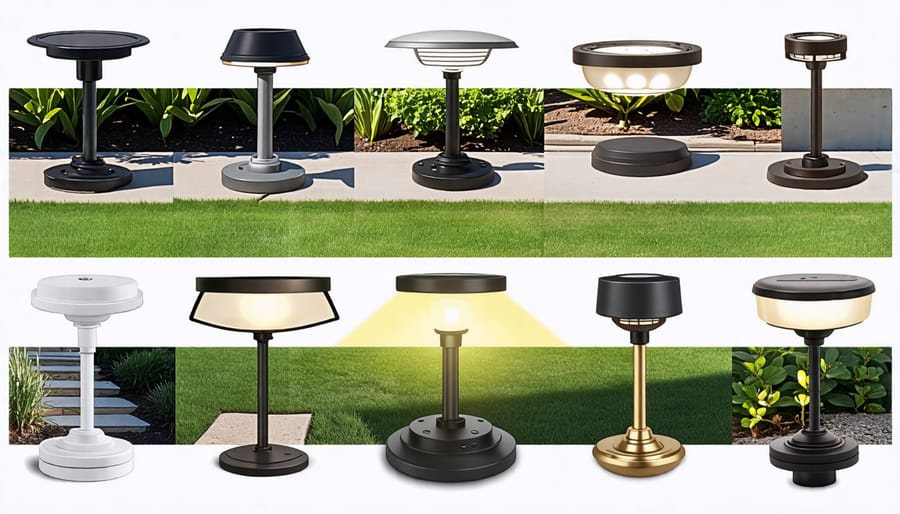
Fixture Types and Styles
Uplighting landscape fixtures come in various types and styles to suit different needs and preferences. Bullet lights are compact, versatile fixtures that can be easily hidden among plants or rocks for a subtle uplighting effect. Well lights, installed in-ground, provide a dramatic look by shining light upwards from below. Spotlights and floodlights are powerful options for illuminating larger trees, walls, or architectural features, with adjustable beam angles for precise aiming. Hardscape lights, designed for integration into retaining walls, steps, and other masonry elements, create a seamless and stylish uplighting effect. For a more decorative touch, consider garden bollard lights or path lights with upward-facing light sources. With finishes ranging from sleek stainless steel to rustic copper and durable powder-coated aluminum, there’s an uplighting fixture to complement any landscape design aesthetic. Choose between line-voltage and low-voltage options, as well as conventional or LED light sources, to best meet your energy efficiency and maintenance requirements.
LED vs Traditional Bulbs
LED bulbs are the superior choice for uplighting landscape lighting due to their energy efficiency, long lifespan, and versatility. Compared to traditional incandescent or halogen bulbs, LEDs consume significantly less power while producing the same amount of light, resulting in lower energy bills. They also last much longer, with an average lifespan of 50,000 hours or more, reducing maintenance and replacement costs. Additionally, LEDs come in a wide range of colors and color temperatures, allowing for greater customization of your lighting design. With the advancements in LED lighting options, there’s no reason to settle for outdated, inefficient traditional bulbs in your uplighting setup.
Wired vs Solar Powered
When deciding between wired or solar powered uplighting for your landscape, consider the pros and cons of each option. Wired uplighting offers consistent, reliable illumination and a wider selection of fixture styles. However, it requires professional installation and may involve disrupting your landscaping. Solar powered uplighting is easier to install and provides flexibility in placement, as no wiring is needed. The downside is that solar fixtures may have less powerful illumination and are dependent on sufficient sunlight to recharge. Ultimately, your choice depends on your specific lighting needs, budget, and landscape layout.
Uplighting Installation Tips
Planning and Layout
When planning your uplighting layout, consider the key features you want to highlight, such as trees, architectural elements, or water features. Start by walking around your property at night and identifying potential focal points. Sketch a rough layout of your landscape, marking the locations of your chosen fixtures. As a general rule, space fixtures 6 to 8 feet apart for even illumination, but adjust as needed for specific features or effects.
Choose fixtures with adjustable beam angles to fine-tune the lighting on-site. Opt for warm color temperatures (2700K-3000K) for a natural, inviting ambiance. Consider using multiple smaller fixtures for a layered, subtle effect rather than flooding an area with a single bright light. Avoid placing fixtures too close to windows or seating areas to minimize glare. Lastly, always check local codes and regulations before installing any electrical components outdoors.
Avoiding Common Mistakes
When installing uplighting landscape fixtures, avoid common mistakes to ensure optimal performance and aesthetics. One pitfall is placing lights too close to structures or plants, which can create harsh shadows and uneven illumination. Maintain a sufficient distance to allow the light to spread evenly. Another mistake is using fixtures with the wrong beam angle. Wide angles can lead to light spillage and glare, while narrow angles may not provide adequate coverage. Choose the appropriate beam angle for your specific application.
Overloading electrical circuits is another common error. Ensure your system has the proper wattage capacity and use a dedicated circuit if necessary. Lastly, don’t neglect regular maintenance. Keeping lenses clean, checking for damaged wiring, and adjusting fixture positions as plants grow will help maintain the desired effect and prevent issues. By being mindful of these potential missteps, you can create a stunning and trouble-free uplighting design for your landscape.
Uplighting Inspiration Gallery
The Uplighting Inspiration Gallery showcases stunning examples of how uplighting can transform landscapes, highlighting architectural features, and creating enchanting ambiances. One striking example features a majestic oak tree, its sprawling canopy illuminated from below by carefully placed uplights. The warm, golden glow emphasizes the tree’s impressive stature while casting captivating shadows on the surrounding lawn.
Another inspiring scene depicts a modern home with clean lines and a minimalist garden. Strategic uplighting along the pathway draws the eye towards the entrance, while accent lights subtly illuminate the home’s facade, creating a sophisticated and inviting atmosphere. The interplay of light and shadow adds depth and dimension to the otherwise simple landscape.
For a more dramatic effect, one showcase demonstrates how uplighting can be used to highlight water features. Submerged lights within a tranquil pond create a mesmerizing shimmer on the surface, while nearby uplights accentuate the texture of a cascading waterfall. The combination of water and light creates a serene and captivating environment perfect for relaxation and contemplation.
These examples merely scratch the surface of uplighting’s potential in landscape design. Whether illuminating towering trees, emphasizing architectural details, or adding a touch of magic to water features, uplighting proves to be a versatile and impactful tool in creating stunning, unforgettable outdoor spaces.

